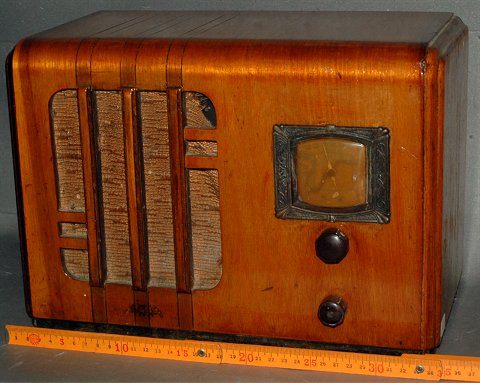
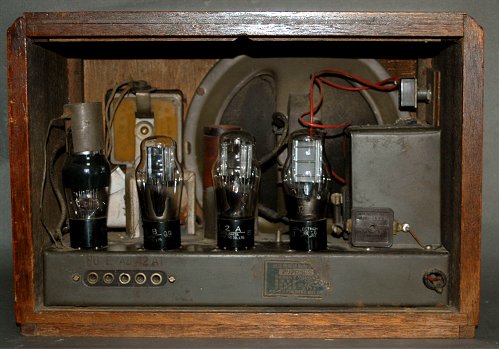
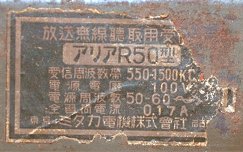
Age of "Nami-Yon" and "San-Pen"
Japanese 4 tubes or 3 tubes TRF low end radio
-1937-39-
Introduction
Radio and Broadcasting in Japan
"Nami-Yon" Radio: 4 Tubes Regenerative Receiver
"San-Pen" Radio: 4 Tubes Regenerative with Pentode Output Stage
Interference by Over Regenerative
"Kou-Ichi" Higher Class Receiver (TRF)
Design
Conclusion
Documents
Radio Museum
NOTICE:
Gothic is latest updates.
Japanese terms or company
names that is untranslatable are shown in spelled in Italics.
When not mentioned specially, all prices are original retail price.
Many commercial broadcasting station existed in U.S.A.
In Europe, listener could receive many stations from neighboring countries.
Then, many superheterodyne receiver put on the US and European market in 1930s.
However, Japanese market was deferent from US and European market.
Superheterodyne receiver was minority.
Main stream of Japanese radio was poor regenerative straight receiver with 3 or 4 tubes.
Radio and Broadcasting in Japan
In 1935, Japanese broadcasting celebrate 10th anniversary.
Listeners increased over 2.5 million.
Production of radio sets increased 150,000 a year and established as industry.
Only one broadcasting corporation existed in Japan.
This is "Nippon Hoso Kyokai (The Broadcasting Corporation of Japan)".
Now It was called "NHK". This abbreviation "NHK" was used from 1946.
Until 1945, It was called "Hoso Kyokai". We will use "NHK" in this article.
In the city 2 wave existed. In other areas only 1 wave was presented.
The greater part of program was sent through the transit network in nationwide.
Then radio set did not need selectivity and sensitivity.
Foreign broadcasting station using same language did not exist around Japan.
Short wave listening was prohibited by government.
Japanese market did not need superheterodyne receiver.
In the country area far away from station, listeners could not buy expensive radio.
Buying power of people was small and technology of manufacturer was poor too.
Cheap and simple set was suitable for Japanese market.
NHK built local stations and increased power of central station to expand their service area.
Then NHK did not need prevailing a high performance radio.
In early 1930s, NHK recommended low cost 3 tube radio which was crystal detector with 2 stage amplifier or triode detector with single amplifier.
These recommended circuit certainly realized low cost.
However, sensitivity was not enough. These radio did not prevailed.
A little bit higher circuit became main stream of Japanese radio.
"Nami-Yon" Radio: 4 Tubes Regenerative Receiver
Most prevailed radio had regenerative grid detector with 2 stages amplifier
(transformer coupling) and half bridge rectifier.
Early model used triode : 227-226-226 (or 112A)-112B.
After 1934, the shape of tube changed from grove to dome. Tubes changed into following line up: 27A-26B-26B (or 12A)-12B.
After 1935, Tetrod 24B sometimes used for detector.
In 1937, The price of new tubes were reduced. New 56 used for detector.
And new rectifier tube 12F put on the market in same price of old 12B.
The output current and plate voltage of 12F was improved from 12B.
12B fade out from market.
At war time, to reduce strategic materials, transformer coupling changed
into resister coupling amplifier.
New pentode 57 used for detector. The line up of later model was 57-56-12A-12F.
Magnetic cone speaker (8") always used.
Such prevailed 4 tube regenerative radio was low performance and low cost.
The persons concerned of radio industry called such radio “Nami-yon”.
Japanese term “Nami” means “average”. “Yon” means “four”
“Nami-yon” means “average 4 tube radio”.
This term used after around 1935 as slang.
After 1940, the term “Nami-yon” appeared on the official documents.
It became official term.
"San-Pen" Radio: 3 Tubes Regenerative with Pentode Output Stage
Another prevailed radio was 3 tubes regenerative with single resister
coupled amplifier using pentode tube.
The line up of tubes were 24B-47B-12B (early model) or 57-47B-12F (later model).
Such radio was called “San-pen”. Japanese teem “San” means “three” and “pen” means “pentode”.
This circuit realized small set, however total gain was lower than 4 tube set.
Therefore “San-pen” radio used mainly high field intensity and city area.
The price of pentode tube was higher than triode tube.
The price of “San-pen” radio was similar to “Nami-yon” radio.
“Nami-yon” and “San-pen” radio always equipped magnetic cone speaker.
Interference by Over Regenerative
Nami-yon and San-pen radio has no volume control.
Volume was controlled by tickler knob.
This control was difficult and stability of set was poor.
Regenerative set sometimes oscillated and caused interference to another radio sets.
NHK was having much trouble in dealing with the matter.
Ministry of telecommunication and NHK recommended “ No interference regenerative set”.
This set had limited or pre-set tickler control.
Manufacturer tried to development of such set, however, sensitivity was lower than ordinary regenerative set.
“No interference regenerative set” did not prevailed.
"Kou-Ichi" Higher Class Receiver (TRF)
The radio set for middle class or weak field intensity area was 4 tubes
TRF set (1-V-1).
These radios called “Kou-Ichi” means TRF with single RF amplifier.
The early line up of tube was 24B-24B-47B-12B.
Late type was 58-57-47B-12F.
New small rectifier tube 12F could supply enough power to drive small electro-dynamic
speaker.
Low cost dynamic speaker set appeared after 1937.
90% of Japanese radio set was 3 or 4tubes regenerative set .
A few superheterodyne radio, radio phonograph and all wave radio for export existed.
Almost of all Japanese radio cabinet was wooden table-top type.
Design was changed from tombstone to horizontal cabinet with airplane dial.
At late 1930’s , war continued in China. Japanese market was boomed by munition industries. Many high grade finished and sophisticated cabinet appeared.
Gradually materials for civilian radio sets were restricted by war.
Design of radio became simplified.
Japan started broadcasting only after 5 years from world first broadcasting.
Until late 1920’s Japanese radio industries caught up to U.S. and European technology.
However, after 1930’s the main stream of Japanese radio set stopped progress from regenerative circuit.
In early 1940’s The progress of civilian electronics was stagnant by war.
The level of radio industries could not catch up to U.S. and Europe until late 1950’s.
TOP
"The Spread of Nami Yon Kyu Innovation of Radio Receivers in Prewar
Japan" Atsushi Hiramoto Kagaku Gijyutushi No.8 8 12/2005 No.9 10/2006
Radio Year Book 1937, 1938, 1940 Nippon Hoso Kyokai
Nami-Yon (4 Tubes Regenerative) Receiver
Aria Model R50 Mitaka Denki K.K. 1937?
Crown Model R10 The Nihon Seiki Co., Ltd. 1937?
Crown Model 480 The Nihon Seiki Co., Ltd. 1938 JPY 31.00 (Link to other file)
Condor "Sensho-go" Nippon Tsushin Kogyo K.K. 1938?
Sharp "Meicho" No.1 Hayakawa Metal Works 1937 JPY 25.00
Sharp "Meicho" No.2 Hayakawa Metal Works 1938 JPY 30.00
National Model Z-2 Matsushita Radio MFG Co., Ltd. 1937 JPY 22.00
Nanaora Model 53 Nanao Radio Co., Ltd. 1937 JPY 27.50
Hermes Model 24A Osaka Transformer Co.,Ltd. 1937 JPY 32.00 (Link to other file)
Hermes Model 57A The Osaka Musen Co., Ltd. 1939
San-Pen (3 Tubes Regenerative with Pentode Detector) Receiver
Olympic Model 49 Showa Musen Kogyo K.K. 1937?
Sharp Model TM-32 Hayakawa Metal Works 1937 JPY 30.00
National Model New Z-1 Matsushita Radio MFG Co., Ltd. 1938 JPY 26.00
Televian Model EC-21 Yamanaka Electric Co., Ltd. 1938?
Kou-Ichi (TRF with RF stage) Receiver
Sharp Model D-35 Hayakawa Metal Works 1937 JPY 56.00
Sharp Model 58 Hayakawa Metal Works 1937-39 JPY 55.00 (Link to other file)
TELEVIAN Model ED-7 Yamanaka Electric Co., Ltd. 1938?
National Model NR-48(Chassis) Matsushita Radio MFG Co., Ltd. 1938
National Model R-4D3 Matsushita Radio MFG Co., Ltd. 1938 JPY 70.00
National Model Z-3 Matsushita Radio MFG Co., Ltd. 1938 JPY 37.00
TRF Receiver (Foreign Sets)
Emerson #BA199 4 Tubes Transformer-less Emerson Radio & Phonograph Company(U.S.A.) 1938 $9.95
Nami-Yon (4 Tubes Regenerative) Receiver
Aria Model R50 4 Tubes Regenerative Mitaka Denki K.K. 1937?



TUBES: 24B(57S)-26B-12A-12F , Magnetic Speaker
Typical 1930's "Nami-Yon "radio with airplane dial.
This set was Repainted.
(Collection No.11590)
Crown Model R10 4 Tubes Regenerative The Nihon Seiki Co., Ltd. 1937?
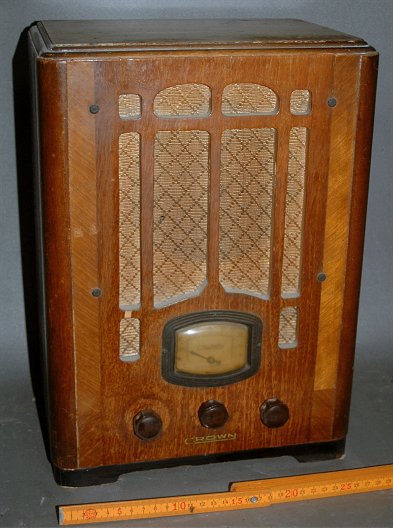
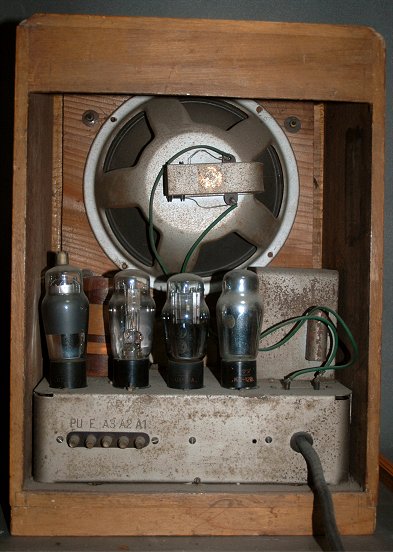
TUBES: 57-27A-12A-12B(12F) , Magnetic Speaker
Tombstone styled "Nami-Yon "radio with airplane dial.
Approved speaker used.
(Collection No.11148)
Condor "Sensho-go" 4 Tubes Regenerative Nippon Tsushin Kogyo K.K. 1938?
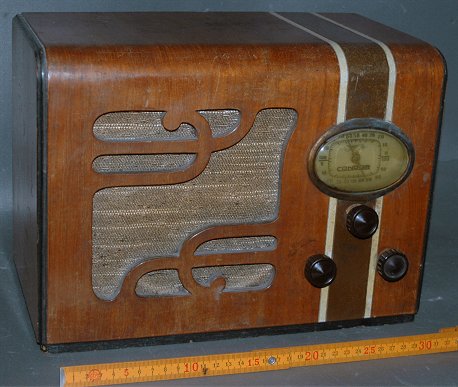
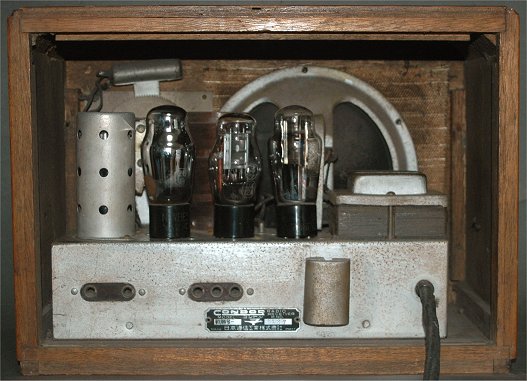

TUBES: 56-26B-12A-12F , Magnetic Speaker
大正時代から続くコンドルブランドの坂本製作所が合併により日本通信工業となった直後のものと思われるセット。時代を反映して、勇ましい名前が付いている。コンドルのラジオ部門は日本通信工業の一部門として存続したが、坂本製作所時代ほどうまくはいかず、戦況の悪化にしたがって本業の通信機に集中するようになり、ラジオからは撤退した。
同社は戦後すぐにラジオに復帰しようとしたが成功せず、通信機専門メーカとして最近まで存続したが、2001年にNECインフロンティアと社名変更し、2006年にNECの完全子会社となった。
現在は1999年に分離、独立した日通工エレクトロニクスが本来のブランドを使用している。
(Collection No.11778)
National Model Z-2 4 Tubes Regenerative Matsushita Radio MFG Co., Ltd. 1937 JPY 22.00
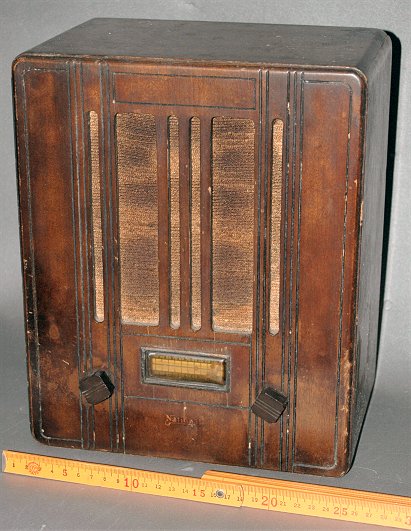
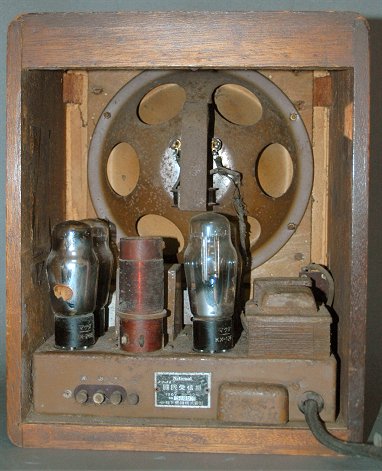
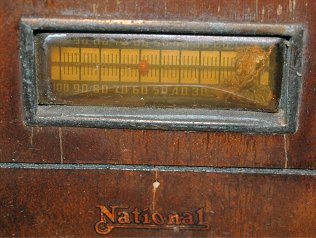
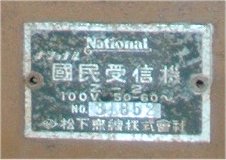
TUBES: 27A-26B-12A-12B , Magnetic Speaker
This model was Matsushita’s low cost small set.
Matsushita called small slide rule dial “Rolling Dial”.
Cabinet is fear condition. Rear cover was missing.
(Collection No.11011)
Sharp "Meicho" No.1 4 Tubes Regenerative Hayakawa Metal Works 1937 JPY 25.00
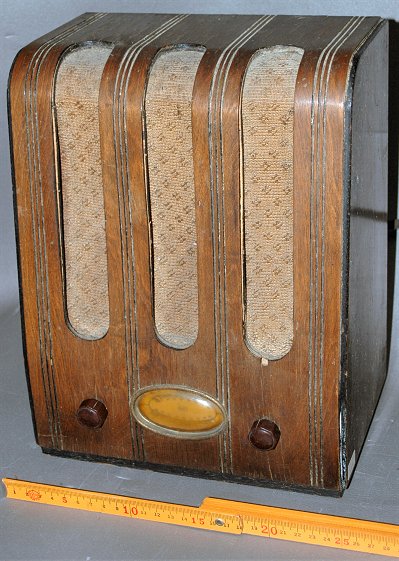
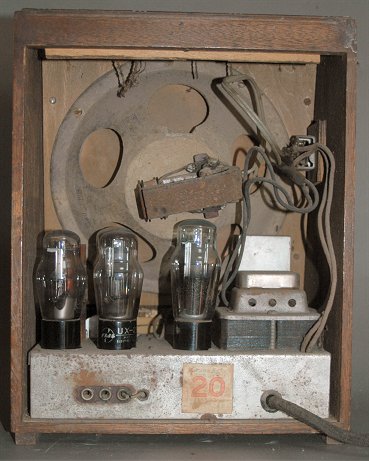
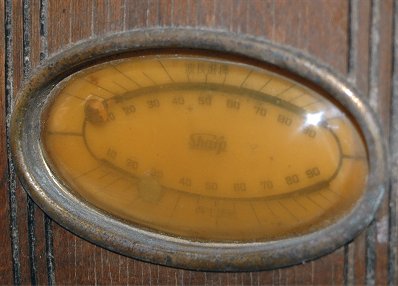
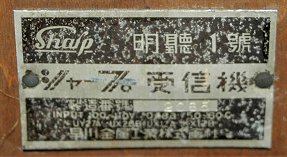
"Meicho dial"Upper area is tuning, Lower area is tickler.
TUBES: 27A-26B-12A-12B , Magnetic Speaker
This model was cheapest model of Sharp’s 1937 catalogue.
The name “Meicho” means “Receiving Clean”.
This model designed for protect interference by over regenerative.
Moving area of tickler controller knob were limited by dial indicator.
This model was not suitable for DX listening.
To reduce the cost, triode used for detector tube.
1940's Paper Framed Speaker was unoriginal.
(Collection No.11010)
Sharp "Meicho" No.2 4 Tubes Regenerative Hayakawa Metal Works 1938 JPY 30.00
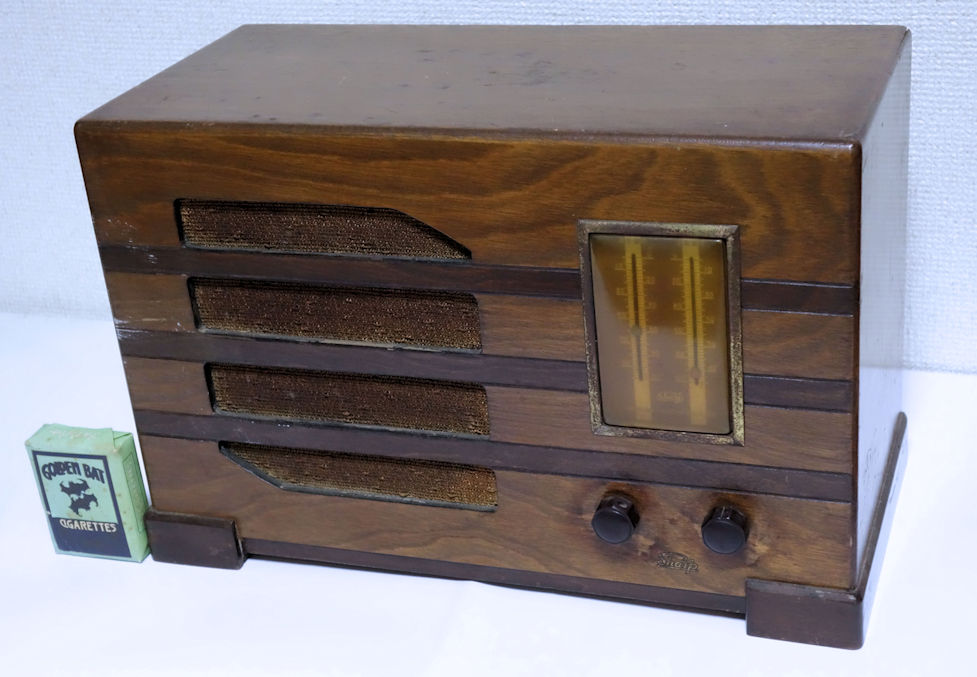
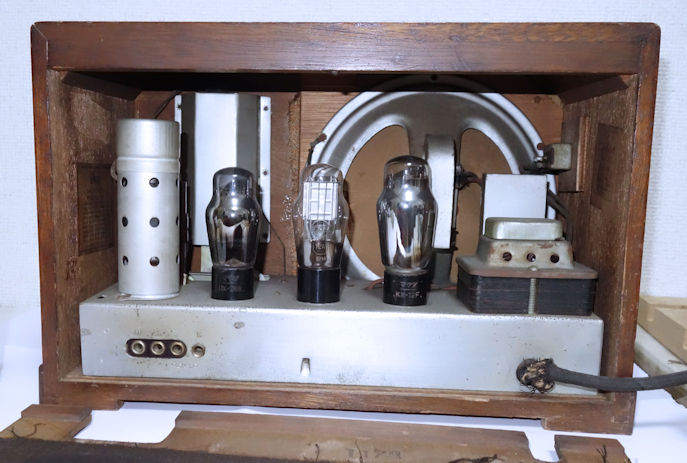
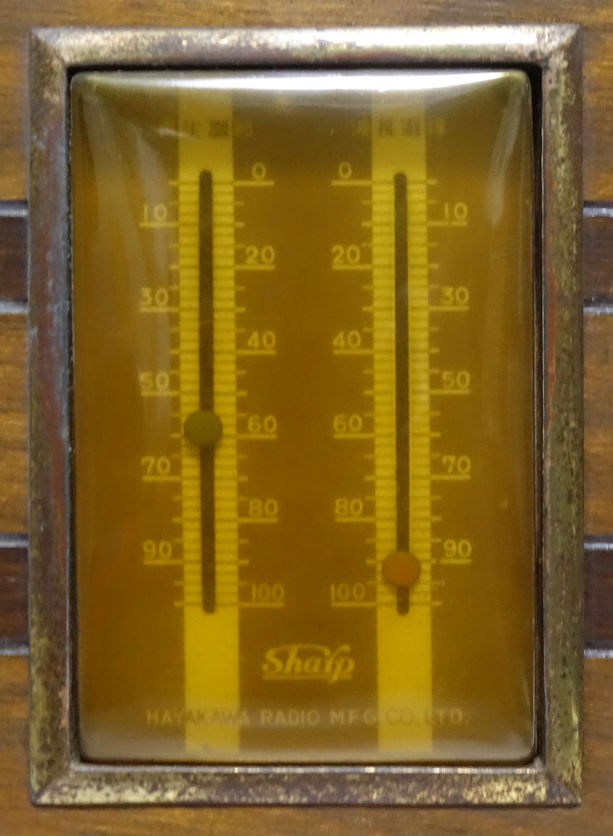
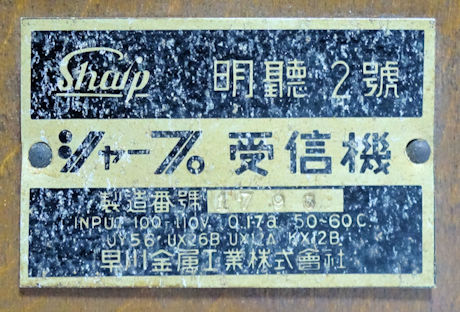
"Meicho dial"Upper area is tuning, Lower area is tickler.
TUBES: 56-26B-12A-12F , Magnetic Speaker
This model was 2 nd model of Sharp Meicho series.
Tombstone shaped cabinet was changed into horizontal shape.
Dial was larger but concept of limited tickler controller was same.
Detector tube was changed from old 27A into 56.
Speaker was missing.
(Collection No.11760)
Nanaola Model 53 4 Tubes Regenerative (Nanao Radio Co., Ltd. 1937) JPY 27.50
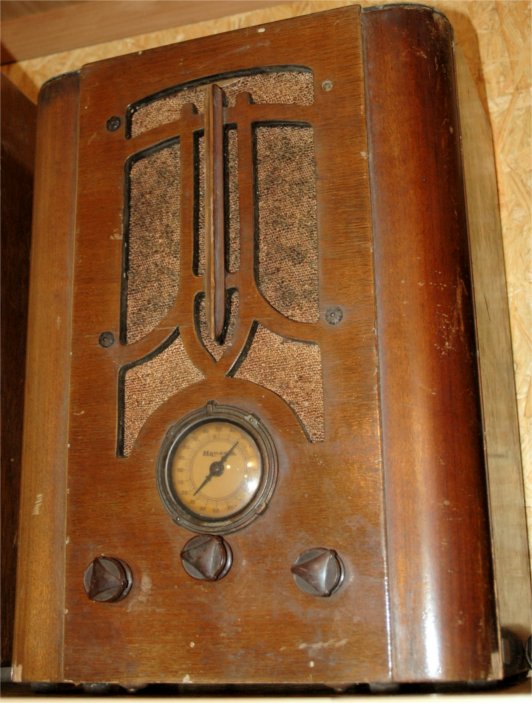
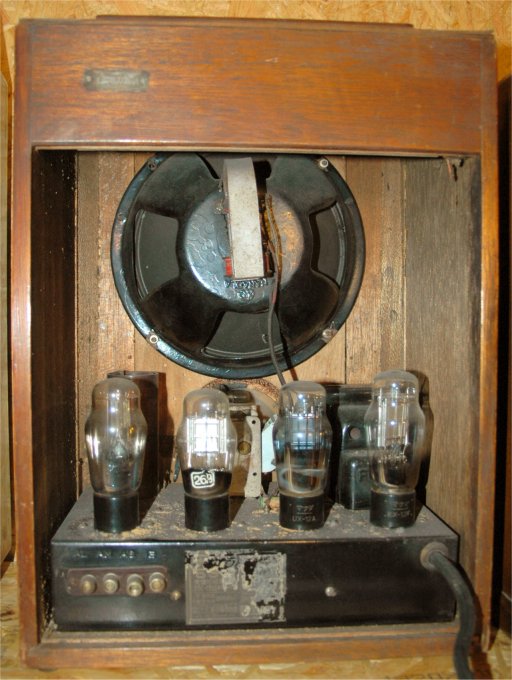
TUBES: 27A-26B-12A-12B , Magnetic Speaker
This set was Nanao Radio’s low cost set with triode detector.
Airplane dial was used.
(Collection No.11517)
Hermes Model 57A 4 Tubes Regenerative The Osaka Musen Co., Ltd. 1939
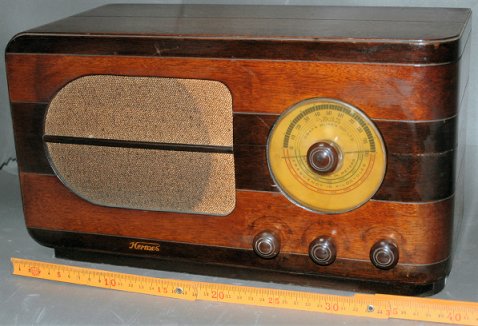
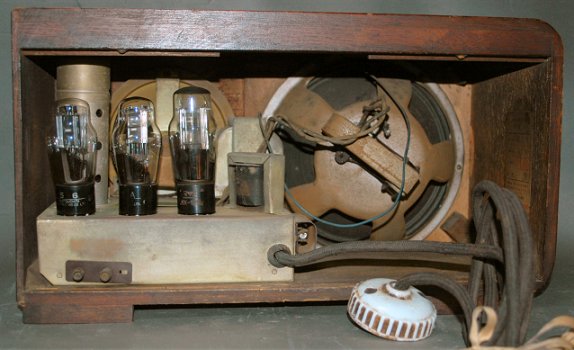
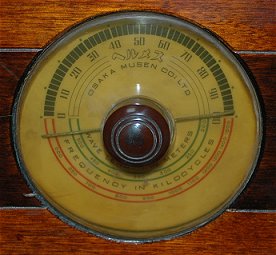
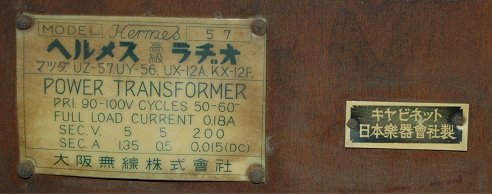
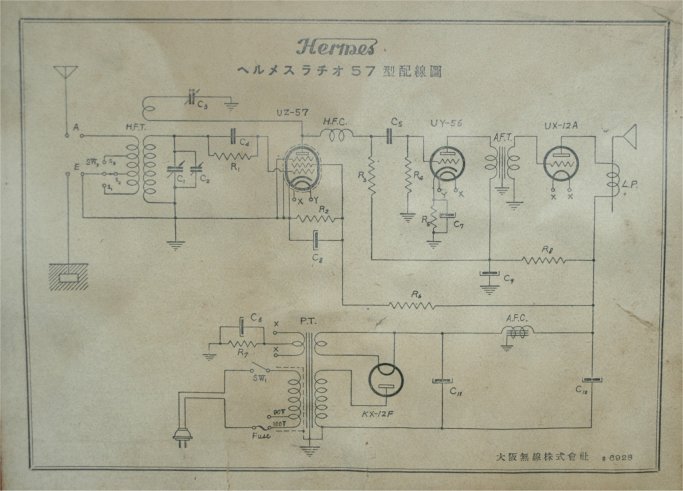
TUBES: 57-56-12A-12F , Magnetic Speaker
Osaka Musen manufactured high quality and high grade set.
Cabinet was made by Nippon Gakki (YAMAHA).
Design was modernized, but circuit was classic transformer coupled amplifier.
(Collection No.11645)
San-Pen (3 Tubes Regenerative with Pentode Output Stage) Receiver
Olympic Model 49 3 Tubes Regenerative (Showa Musen Kogyo K.K. 1937?)
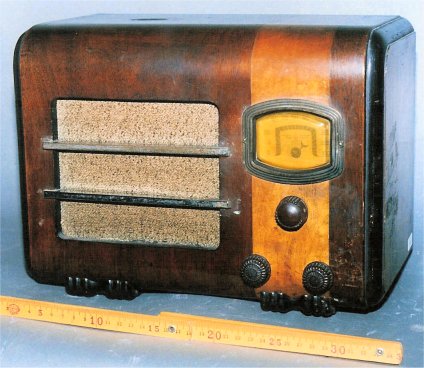
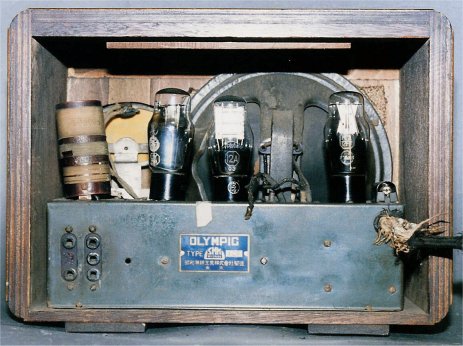
TUBES: 227-112A-112B , Magnetic Speaker
This set was early horizontal styled low cost set with triode detector.
After WWII Showa Musen Kogyo changed their business from radio set into radio parts.
They could not use “Olympic” brand after WWII.
They grew up in electronics industry. They changed their company name “SMK”.
Tubes were changed into 27A-12A-12FK.
(Collection No.11542)
Sharp Model TM-32 3 Tubes Regenerative Hayakawa Metal Works 1937 JPY 30.00
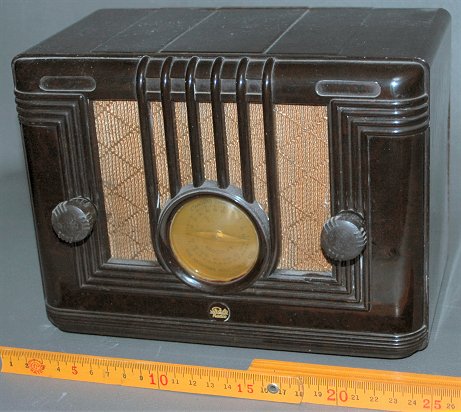
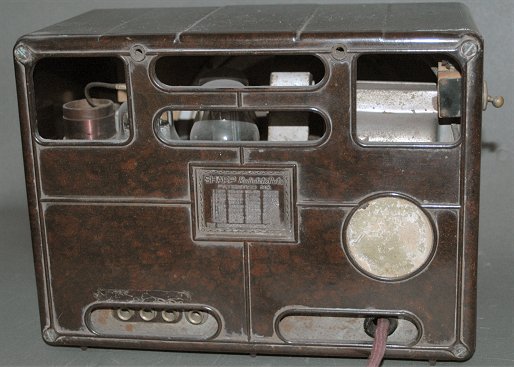
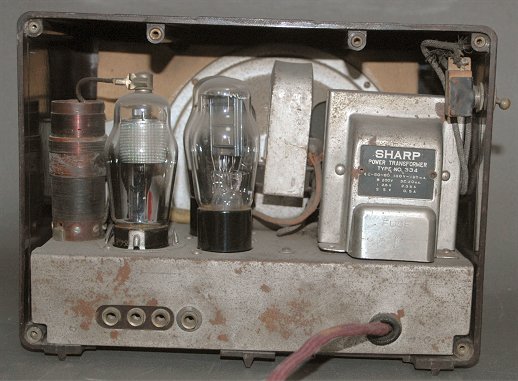
TUBES: 24B-47B-12B , Magnetic Speaker(5")
Hayakawa(Sharp) developed Phenol resin based plastic like Bakelite.
They named the plastic “Sharplite”.
They manufactured small radio set using Sharplite.
The design of cabinet was imitation of Emerson Model 126 (1936).
Emerson’s original was transformer-less circuit.
However Japanese set used transformer. Then set was heavier than original.
(Collection No.11103)
National Model New Z-1 3 Tubes Regenerative Matsushita Radio MFG Co., Ltd. 1938 JPY 26.00
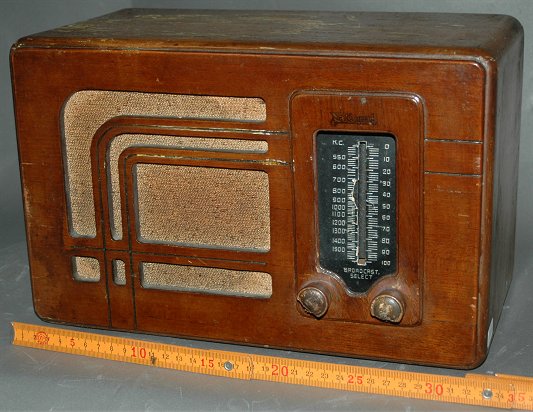
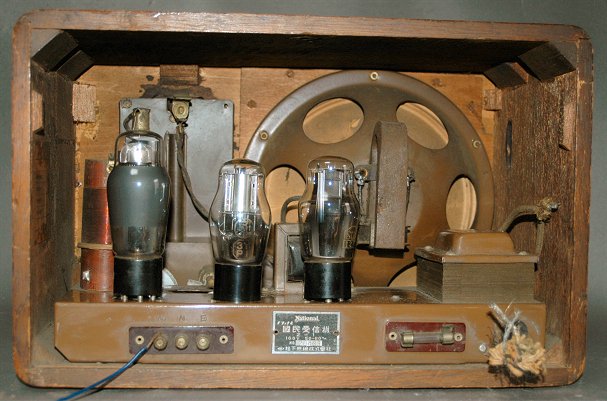
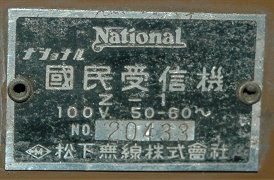
TUBES: 57-47B-12B , Magnetic Speaker
Matsushita sold new series radio named “Kokumin (People’s) radio” in 1937.
This series was low price and had simplified design. Model Z-1 was middle
class of this series.
Model New Z-1 was revised model of Z-1. Original model sold in 1937.
Power switch was removed and wiring had shorten.
(Collection No.11643)
Televian Model EC-21 3 Tubes Regenerative Yamanaka Electric Co., Ltd. 1938?
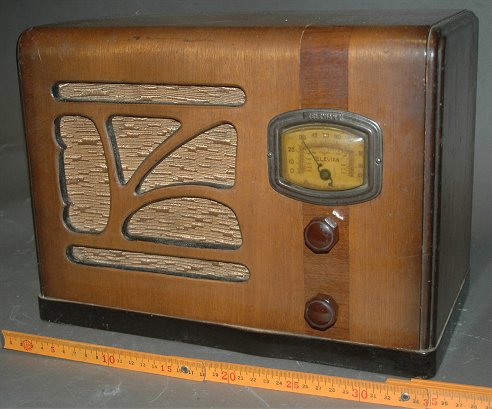
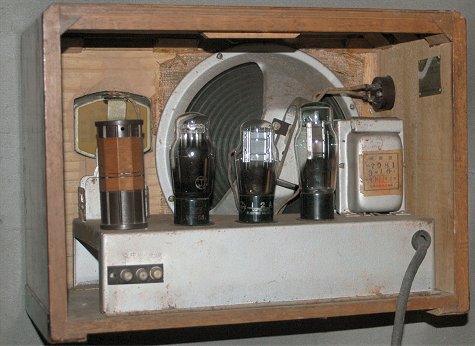
TUBES: 56 12A 12F, Magnetic Speaker
This set is not “San-Pen” radio. Triode detector and triode amplifier tube
were used.
After 1935, tetrode and pentode put on the
market. Such old fashioned low sensitivity set was disappeared.
28/12/1937, test broadcasting of 150kW high power transmitting was started
in Tokyo.
The service area of low sensitivity set was
expanded. The cost of pentode was higher than triode.
3 tube set with triode detector and triode
amplifier revived after 1938 as a low price set.
(Collection No.11939)
Kou-Ichi (TRF with RF stage) Receiver
Sharp Model D-35 4 Tubes TRF Hayakawa Metal Works 1937 JPY 56.00
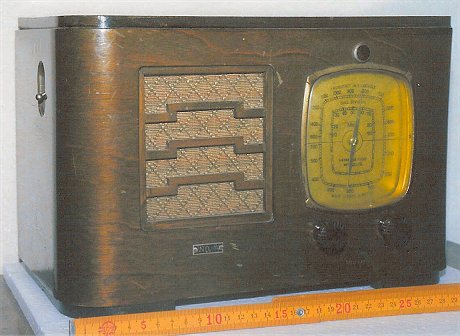
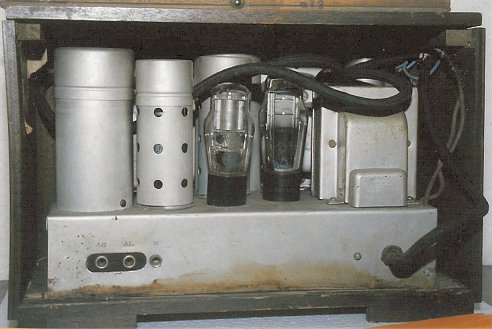
TUBES: 24B-24B-47B-12F , Electro-Dynamic Speaker
Hayakawa's intermediate receiver. 24B-24B-47B-12F drives a 5-inch electro-dynamic
with 4 tubes TRF. The design of the dial was seen in the set of Emerson,
USA. Such a large airplane dial is rare in Japan. This set has a pilot
lamp that was not originally attached, and a nameplate "No. 1"
is attached under the speaker. It seems that it was not used for home use,
but for some kind of commercial purpose.
(Collection No.11200)
Televian Model ED-7 4 Tubes TRF (Yamanaka Denki K.K 1938?)
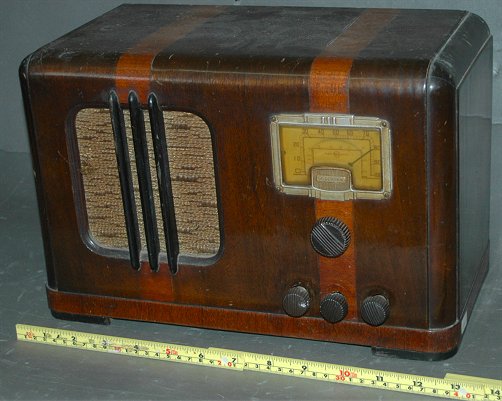
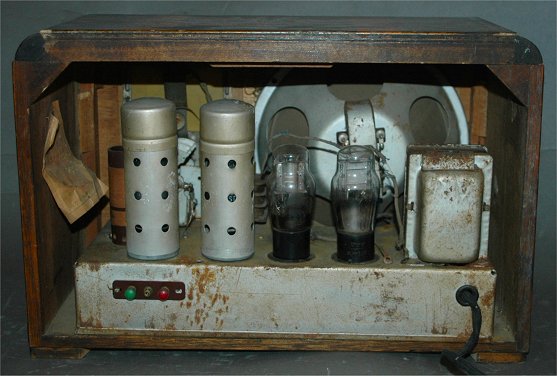
TUBES: 24B-24B-47B-12F , Magnetic Speaker
Typical TRF receiver manufactured by one of the big corporation at pre
war era in Japan.
The quality of this set kept high level. This was the last "good old
days" set at pre war era.
Rear cover was missing.
(Collection No.11417)
National Model NR-48(Chassis) 4 Tubes TRF, Matsushita Radio MFG Co., Ltd. 1938
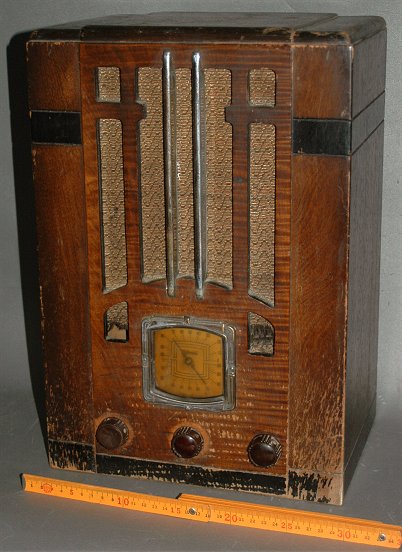
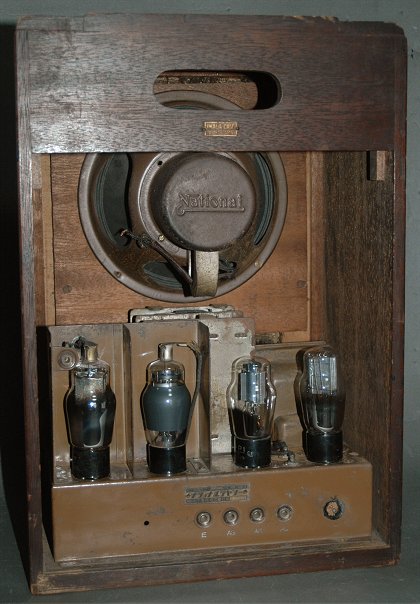
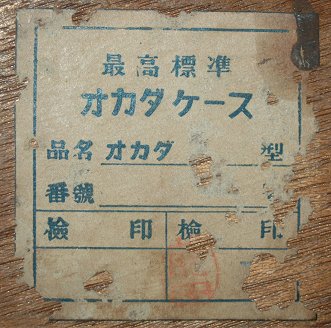
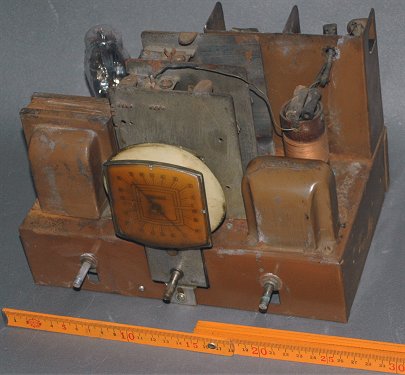

TUBES: 24B-24B-47B-12B , Magnetic Speaker National Model M-10
An improved model of Matsushita's best-selling model R-48 and sold as a chassis. The cabinet is made by Osaka's major cabinet maker, Okada Case, and the speaker is Matsushita's genuine National M-10 model. This chassis has changed the original R-48 vacuum tube layout, removed the excess shield case, and made it one size smaller. The chassis paint was also changed from the black of the R-48 to brown, which was the standard chassis paint at Matsushita at the time. The design of the cabinet is similar to the original R-48 type, but the size is one size smaller. Around the end of 1937, the "Matsushita Electric Products Catalog" refers to this chassis as the "AR-48" type. At that time, chassis-only products were sold for customers who could not afford a complete set. Combine this with cheap cabinets, speakers, and second-rate vacuum tubes, and you could supply a National-brand radio for half the price of a finished National product. This set uses the same speakers as the genuine product and a cabinet from a first-class manufacturer, so it can be said that it is a fairly high-class assembled radio.
This set seems to have been used until after the war, and the vacuum tubes
were replaced with 57S and 3YP1, and there are traces of repairs inside
the chassis.
(Collection No.11785)
National Model R-4D3型 4 Tubes TRF, Matsushita Radio MFG Co., Ltd. 1938 JPY 82.00
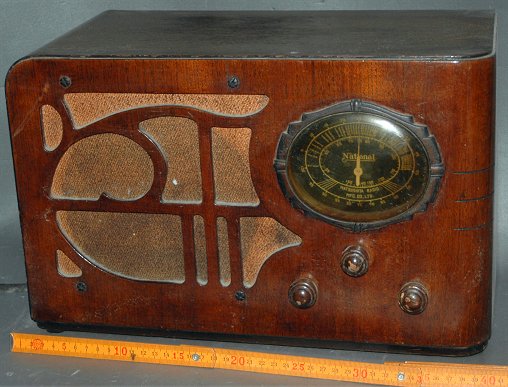
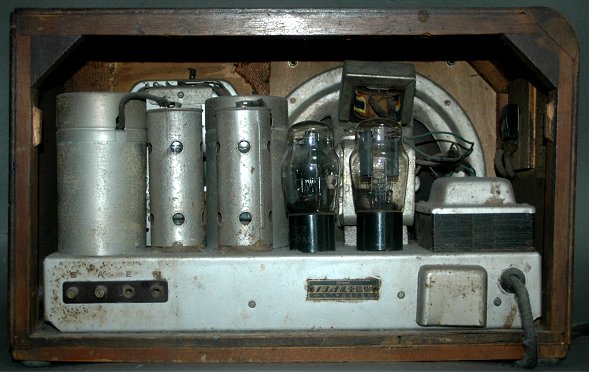
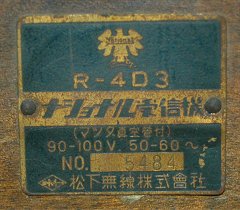
TUBES: 58-57-2A5-80 , Electro-Dynamic Speaker (National)
Matsushita's high-grade four-tube TRF receiver. It drives an in-house electro-dynamic.
In order to improve the sound quality, 57 is used as a plate detector for
fixed regeneration, and NFB is applied to the output. You can also change
the color of the dial illumination with the "Magic Switch".
(Collection No.11012)
National Model Z-3 4 Tubes TRF, Matsushita Radio MFG Co., Ltd. 1938 JPY 37.00
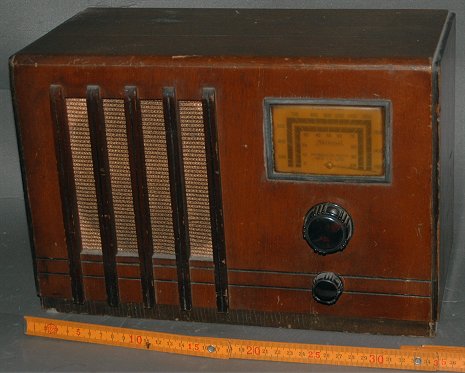
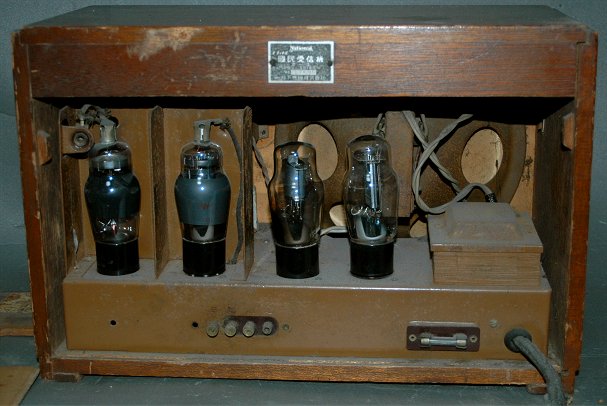
TUBES: 24B-24B-47B-12B , Magnetic Speaker
Matsushita sold new series radio named “Kokumin (People’s) radio”.
This series was low price and simplified design.Model Z-3 was high grade
model of this sereis.
This model had ordinary regenerative grid detector.
Ordinary B.C. band set used variable capacitor to control.
However tickler was controlled screen voltage by variable resister.
Such circuit used for short wave radio.
Knob was unoriginal. Tube was changed from 24B-24B into 58-57S.
(Collection No.11314)
TRF Receiver (Foreign Sets)
Emerson #BA199 4 tubes, TRF, Transformer-less, Emerson Radio & Phonograph Company (U.S.A.) 1938
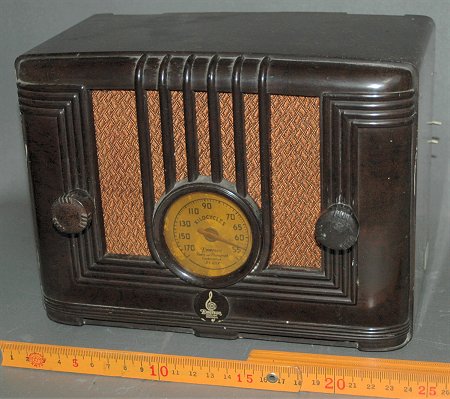
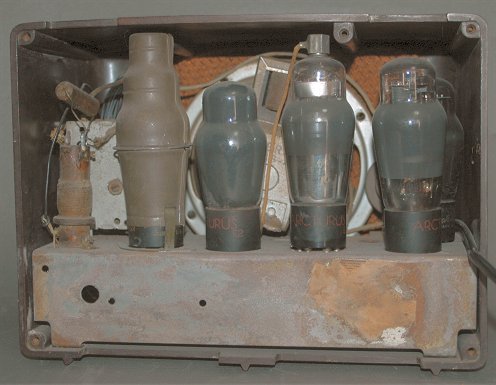
TUBES: 6D6 - 6C6 - 25L6G - 25Z5 - L55B-G , Electro-Dynamic Speaker(5")
This was Emerson’s small TRF set. Cabinet made by Bakelite.
Model BA199 was minor changed model of Model 126.
Color variation (white) existed.
Rear cover and dial cover was missing.
(Collection No.11477)